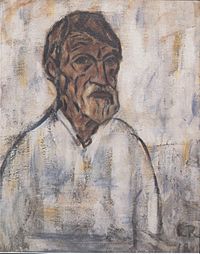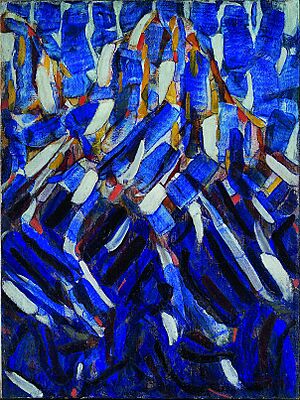Christian Rohlfs facts for kids
Quick facts for kids
Christian Rohlfs
|
|
|---|---|

Christian Rohlfs, self-portrait (1918)
|
|
| Born |
Christian Rohlfs
22 November 1849 Groß Niendorf, Kreis Segeberg, Prussia
|
| Died | 8 January 1938 |
| Nationality | German |
Christian Rohlfs (born November 22, 1849 – died January 8, 1938) was a German artist. He was a painter and also made prints. He is known as one of the most important artists of Expressionism in Germany.
Contents
Early Life and Learning to Paint
Christian Rohlfs was born in a place called Groß Niendorf in Prussia. When he was a teenager, he got a serious infection. This infection later led to him losing a leg in 1874. While he was recovering, he started painting.
In 1870, he began to study art formally in Berlin. Later, he moved to the Weimar Academy to continue his art education.
Becoming a Professional Artist
In 1901, Rohlfs moved from Weimar to Hagen. There, he met an art collector named Karl Ernst Osthaus. Osthaus offered Rohlfs a studio in a building that would later become the Museum Folkwang. Rohlfs was the very first artist to work there.
Meeting artists like Edvard Munch and Emil Nolde changed his art. Seeing the paintings of Vincent van Gogh also inspired him. These experiences helped him move towards the Expressionist style. He continued to paint in this style for the rest of his life.
Making Prints
In 1908, when he was 60 years old, Rohlfs started making prints. He saw an exhibition of works by an Expressionist group called Die Brücke. This inspired him to try printmaking.
He made 185 prints in total. Most of these were woodcuts or linocuts. From 1910 to 1912, he lived in Munich and Tyrol. After that, he returned to Hagen.
When World War I started, Rohlfs was very worried. For some time, he felt he could not paint. Sometimes, he would add a lot of color to his prints by hand. This made them look almost like paintings. An example is his 1919 coloring of Der Gefangene, which he had made the year before.
Later Years and Challenges
In May 1922, Christian Rohlfs joined the International Congress of Progressive Artists. He signed a statement to help start the "Union of Progressive International Artists."
Later, in 1937, the Nazi government in Germany caused problems for him. They removed him from the Prussian Academy of Arts. They called his art "degenerate art" (meaning it was seen as bad or harmful). His works were taken out of public art collections. Seventeen of his paintings were even shown in the "Degenerate Art Exhibition" in 1937.
Christian Rohlfs passed away in Hagen, Westfalia, on January 8, 1938.
Art Style and Techniques
Throughout his career, Rohlfs tried many different art styles. These included academic, naturalist, Impressionist, and Post-Impressionist styles. Many people see him as one of the very first Expressionist artists.
Awards and Recognition
- In 1929, the city of Hagen opened a museum named after Christian Rohlfs.
- He was made an honorary citizen of Hagen.
- He received honorary doctorates from the University of Kiel and the University of Aachen.
Works
See also
 In Spanish: Christian Rohlfs para niños
In Spanish: Christian Rohlfs para niños







